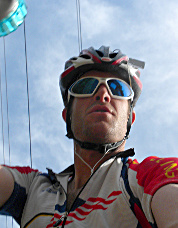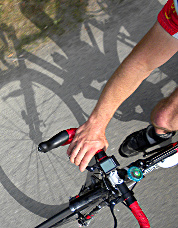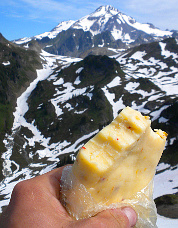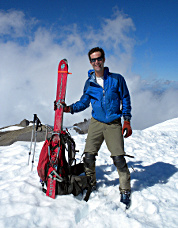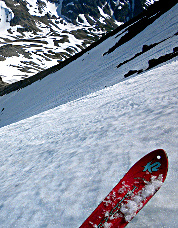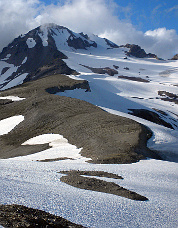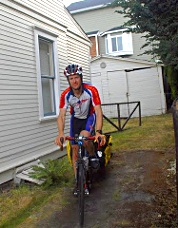|
||||||||||||||||||||
 |
||||||||||||||||||||
 |
||||||||||||||||||||
|
The irony was almost painful—in an effort to honor a friend’s request to drive his car at least once while I house-sat for him, I had stranded myself between an early-morning work function (yep, the banana peels) and my loaded-up bike. Instead of putting in some bike miles on another human-powered mountaineering trip, I was calling tow trucks and mechanics. I was itching to pedal. So when I left Seattle in mid-day on an unusually warm Friday in July, I was in a hurry. Despite my anxiety to get this trip moving on schedule, I really wasn’t going anywhere very fast. I had two full panniers and a loaded-up bike trailer with all my camping, hiking, climbing, cooking and ski gear—and most of my food for two and a half days. I ceremoniously tied a piece of orange flagging to my ski tips at the end of the trailer as a finishing touch. My objective: a human-powered approach from Seattle to Glacier Peak, a ski down the volcano’s summit and its satellite, Disappointment Peak, and a bicycle return to Seattle. Three days sounded reasonable, or so I thought when I was conjuring up the idea. But I had to be at work on Monday and Friday was not only stifling hot, but half-shot already. Apparently, I wouldn’t be getting much sleep this weekend. I had planned for about 100 miles to the trailhead on the first day with the intention of hiking several miles as well. I plotted an interesting bike route, winding up the Burke Gilman Trail from Fremont and then over toward Snohomish and up along the Centennial Trail to the Mountain Loop Highway. I hadn’t been on the full Mountain Loop in years—it would be a good opportunity to return to familiar landscape. I was unaware that a grader had just passed through Barlow Pass and that navigating this route with skinny tires and a trailer in tow would be more than frustrating at about mile 90. Without this knowledge, I pedaled with naďve intensity toward my last taste of asphalt. I was sweating hard, leaving lines of white crust on my shirt and shorts. I was thirsty and thinking of water. The autumn floods of 2003 had taken a toll on the Mountain Loop and on the traditional approach to Glacier Peak via Kennedy Hot Springs. As I pedaled along the Stillaguamish River at Silverton, I realized that more than flooding had influenced the access here. At the turn of the 20th century, a flood of prospectors brought Silverton the mix of stores, hotels and newspapers typical of a booming mining community. The lone general store helped me quench my thirst, as I filled up two gallons of water and resumed pedaling upward into the shade of the forest. I dropped off the asphalt onto the gravel as the road pitched up at a steeper incline, forcing me to dig for my reserves. Out of the saddle and giving it all I had (but still going only 4 mph), I caught sight of the trailhead. It was dusk. The transition was quick: extract pack and skis from the trailer, change clothes, shovel calories and water in, stretch for a minute or two, stash bike, laugh at the parking pass reminder sign, and start along the North Fork Sauk River trail. I was able to walk just an hour before fatigue overcame me. I slept well on the uphill side of an old-growth cedar under auspiciously bright stars. In the back of my mind was a fear that I’d wake up too sore to continue. On Saturday morning my alarm didn’t work—but my eyes opened on their own at 4 a.m. I assessed the damage from the previous day’s 100-mile loaded ride. Nothing sore—I actually felt good—but I was clearly dehydrated. I drank, packed up, and was on the trail, climbing toward dawn. I started feeling the weight as the switchbacks accumulated on my legs. I imagined stashing my gear near White Pass and making the ascent of Glacier Peak light and fast. But aware of an incoming weather system and my own solitude, I decided to keep slogging with all my stuff in case something unexpected happened. I shoveled in breakfast #3 and tried to find a pace I could sustain. At 10:00 a.m. I was ready to click into skis. The first views of Glacier Peak from the ridgeline near White Mountain inspire a mixture of “wowza” and “damn, that’s still a long approach.” On this occasion, the scene also prompted thoughts of “where the hell is the snow?” The spring and summer of 2009 brought repeated blasts of heat and the mid-summer snowpack was suffering. I pieced together snow patches down from the ridgeline and managed to find a relatively efficient, gradually ascending line toward Glacier Gap. Reaching Glacier Gap an hour ahead of schedule, I decided it was safe to stash some gear. Without camping and cooking gear, I could ascend much faster and the ski down would be less punishing before the long ride home. I winnowed my pack down to the basics as a cloud began to form over the volcano’s summit. I kept all my clothes with me.
When I reached the crevassed section of the Cool Glacier, I chose a cautious line. Here I spotted distant climbers climbing into clouds near the summit. The weather alternated between intense sunshine and chill as clouds formed and parted overhead. I could see a strong west wind sweeping the summit ridge. When I reached the final slope below the top, I noticed that the other climbers had stashed their skis there, probably because the wind was now sustained at about 40 mph. I secured my skis lower on my pack and started to climb through the blowing pumice, crunchy in my teeth. The wind was strong, but not gusty, so it wasn’t a major hindrance. I trudged up the snow gully, dramatically in and out of the clouds. One second, a view of the whole range. The next second, nothing but white. After checking my watch, I decided I could spare 45 minutes on the summit before skiing down. There I met Phil and Martina, whose smiles and conversation offered welcome, if brief, companionship on an otherwise solitary weekend. Since I had done a similar trip by myself to Mount Rainier just two weeks earlier, I was starting to feel the absence of my usual mountain friends. Before I clicked into my skis, I stood at the summit, looking down along the hopefulness of glaciers in the summer and thought about the demanding elegance of human-powered transport. Certainly I am no Göran Kropp; I’m aware of the tiny scale of my achievement. Yet the weekend ascent from my house to this remote volcano through my own power was satisfying. And I didn’t need even so much as a parking pass. The turns off the summit felt so good that I forgot about saving energy for later. In fact, I decided to endure a bit more wind and climb Disappointment Peak for a descent of its southeast face. With a bit more sun exposure and fewer suncups on that slope, I felt I was getting the most of my 120-mile ski haul. My giddiness was an accessory I’d need for the long skin out. At Glacier Gap I reloaded my overnight gear and retraced my tracks toward White Mountain. When I reached the White Mountain ridgeline, gathering clouds blocked the last rays of the sunset. At about 10:30 p.m., exhausted and without a better idea for a campsite, I collapsed at White Pass, gobbled down food, and attempted sleep. The wind blew like crazy all night, ripping up my tent stakes. I barely got an hour of rest. At 4 a.m. on Sunday morning, I pulled open the zipper of my rain-fly, expecting to find myself in clouds. Instead, I was greeted by stars and a clear orange horizon. I stumbled to my feet as best I could and after packing up started down the trail. I would need all the hours I could get, since I was starting to feel the physical effects of the journey. Within a few hours, I reached the trailhead and uncovered my camouflaged bicycle. I quickly packed up the bike and started rolling along the gravel—this time toward Darrington. I decided to take the long way around, completing the Mountain Loop Highway, since the gravel over Barlow Pass was so hideous. The only downside was a strong headwind between Darrington and Arlington along SR 530. But once I reached the Centennial Trail, I was sheltered and even enjoyed a slight tailwind.
At this point, things got just plain silly. I needed enormous amounts of calories, but my system couldn’t accommodate them. I’d gone from craving fats and complex carbs to only wanting sugar. I knew this wasn’t going to get me 120 miles, so I stopped along the trail and force-fed myself some real food. It was awful. So awful that I felt for a time that I might have compromised my return home. My stomach ached, my muscles didn’t have much left, and my sleep-deprived mind spun. I lay on the ground, sipping water occasionally. I have always said that with enough water and food at the right times, one can do just about anything. Just as I began to question this conviction, I started to feel something change. I got on my bike and started pedaling. And it felt good. What followed was the equivalent of skiing hero snow all the way home. Once into the town of Snohomish, I picked up the pace, charged up Seattle Hill Road, and ran on adrenaline until I pulled up the Fremont hill to my place. It was still light out. I had beer in the fridge, ice-cream in the freezer, and a sunset over the Olympics to enjoy. As I watched the evening light fade to darkness, I pondered the motivations for a trip like this. Of course, a desire to try new things motivates many of us to strike out on new routes. And, in this carbon-constrained world, pumping out more CO2 from an exhaust pipe to access melting glaciers and changing landscapes seems a painful irony. But I also think about another problem: what I’ll call future worship. We’ve become so used to anticipating what comes next that we rarely take time to enjoy where we are now. I am guilty of this and struggle with it every day, but I hope to broaden my sense of what I’m going out to enjoy. Can’t this also include the experience of “getting there?” I imagine taking the train to the mountains in the 1940s, complete with impromptu bands playing in the rail cars and excited skiers enjoying a community of movement. Fast forward to your most recent trip. We make car travel bearable with iPods, Tim’s potato chips and idle chatter, but mostly, that time is just a waiting game. Think “ski to drive ratios.” Think about scrambling for that parking pass. Think about your algorithm for calculating gas contributions from your buddies.
Sure, I’ll still drive to the mountains. And I’ll still look forward to getting there. But once in awhile—and until we have a viable rail option again—I’ll get there without a car. Just as it’s hard to describe to a non-skier how it feels to link telemark turns in deep powder, it’s hard to explain the reward you get from a human-powered trip. So I’ll be happy—every now and then—to cut out the drive and add a feeling of elegance to the trip, taking in the smells and texture of the air, the wild places close to home that we seldom notice, and the gradual and complex transitions in landscape. The feeling of independence is invigorating. And it sure beats calling a tow truck. |
|
|
|||||||||||||||||||||||||||||||||||||||||||||||||||||
| ©2009 Northwest Mountaineering Journal | |||||||||||||||||||||||||||||||||||||||||||||||||||||||
| Site design by Lowell Skoog | |||||||||||||||||||||||||||||||||||||||||||||||||||||||
